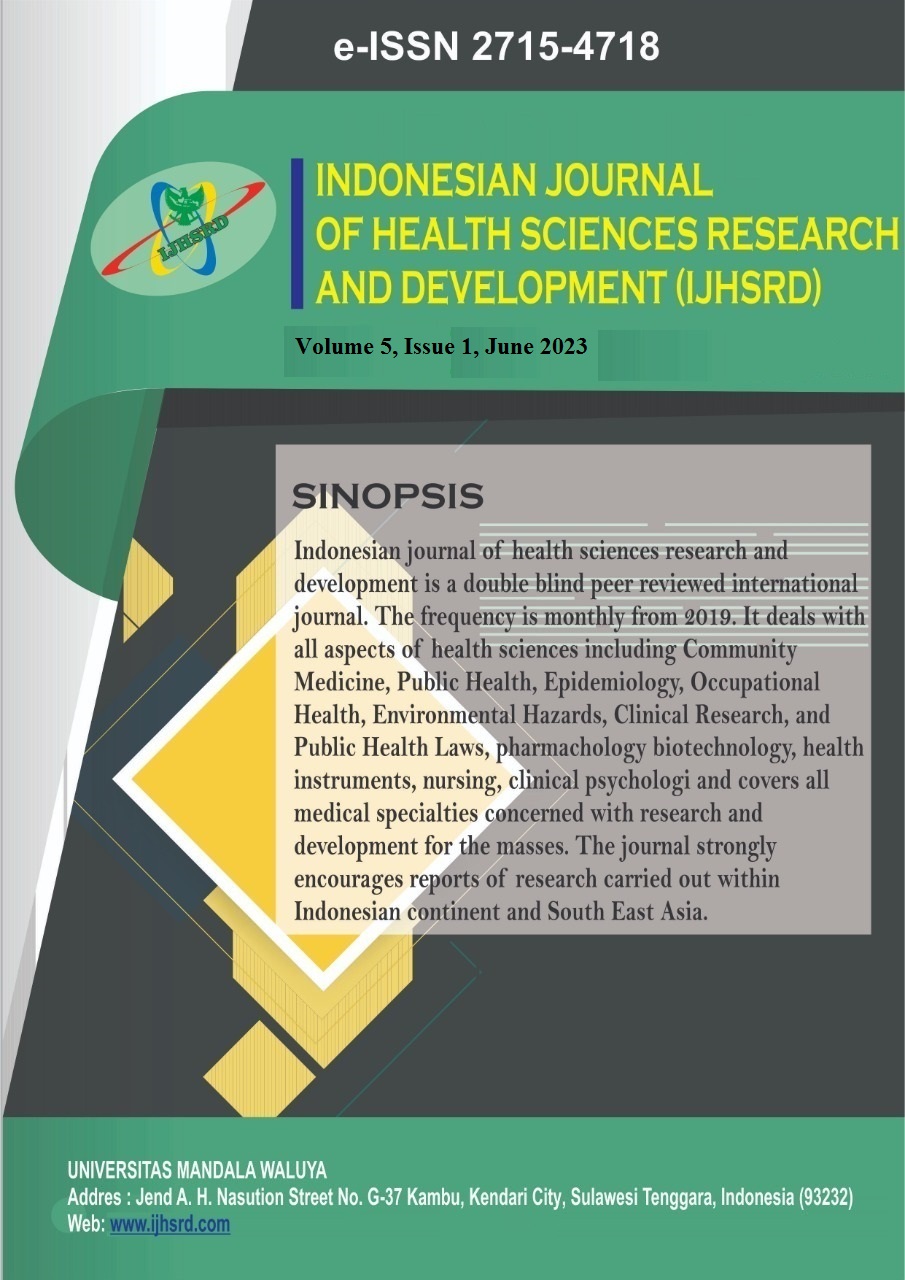Main Article Content
Abstract
Background: Pneumonia is an acute lower respiratory tract infection that affects the lung tissue (alveoli) and is the single biggest cause of death in children under 5 years old. Several factors cause pneumonia, namely, environmental factors, individual child factors, and behavioral factors . The purpose of this study was to determine the relationship between the physical home environment and behavior with the incidence of pneumonia in children.
Methods: This research is an analytic observational study using a Cross Sectional Study design. The population of this study was all mothers who had children aged 0-59 months in 2021 with a total of 1,045 people and 92 samples were obtained from the slovin formula.
Results: We found that out of 92 children who had pneumonia, around 34 children( 37 %) had poor lighting, 34 children ( 37 %) had floors that did not meet the requirements, 36 (39.1%) had ventilation that did not meet the requirements, 20 children(21.7%) family members had a habit of smoking inside the house and 37 (30.2%) house windows that were not opened frequently. The results of statistical tests using the Chi-Square Test concluded that lighting, house floors, ventilation, smoking habits and the habit of opening windows were significantly related to the incidence of pneumonia in children with a p-value of 0.00 ; 0.002 ; 0.004; 0.005; 0.015 respectively.
Conclusions: Physical environmental factors of the house, lighting conditions, floors and ventilation that do not meet the requirements, and factors of smoking behavior and rarely opening the windows of the house are causes of pneumonia in children.
Keywords
Article Details

This work is licensed under a Creative Commons Attribution-ShareAlike 4.0 International License.
References
- Organization World Health, others. Revised WHO classification and treatment of pneumonia in children at health facilities: evidence summaries.
- Zar HJ, Andronikou S, Nicol MP. Advances in the diagnosis of pneumonia in children. Bmj ; 358.
- McAllister DA, Liu L, Shi T, et al. Global, regional, and national estimates of pneumonia morbidity and mortality in children younger than 5 years between 2000 and 2015: a systematic analysis. Lancet Global Heal 2019; 7: e47--e57.
- Roquilly A, Torres A, Villadangos JA, et al. Pathophysiological role of respiratory dysbiosis in hospital-acquired pneumonia. Lancet Respir Med 2019; 7: 710–720.
- Ministry of Health. Indonesia Health Profile 2020, Ministry of Health of the Republic of Indonesia.
- Southeast DKPS. Southeast Sulawesi Province Health Profile in 2021 . 2021.
- Nambo Community Health Center N. Health Profile of the Nambo Community Health Center in 2021 . 2021.
- Dean P, Florin TA. Factors associated with pneumonia severity in children: a systematic review. J Pediatric Infect Dis Soc 2018; 7:323–334.
- Sutriana VN, Sitaresmi MN, Wahab A. Risk factors for childhood pneumonia: a case-control study in a high prevalence area in Indonesia. Clin Exp Pediatr 2021; 64:588.
- Nasrin S, Tariqujjaman M, Sultana M, et al. Factors associated with community acquired severe pneumonia among under five children in Dhaka, Bangladesh: A case control analysis. PLoS One 2022; 17: e0265871.
- Rasyid R, Dirawan GD, Umar R, et al. Relationship between physical conditions of houses building with pneumonia disease events in children participants of poor people in Makassar City, South Sulawesi, Indonesia. IOSR J Humanit Soc Sci 2018; 23:85–91.
- Harnani Y, Hamidy R, Sukendi DA. Spatial analysis of pneumonia in children based on environmental, individual, and behavioral factors in Pelalawan Regency, Riau Province. Indian J Forensic Med & Toxicol 2020; 14:4093–4099.
- Saied WI, Mourvillier B, Cohen Y, et al. A comparison of the mortality risk associated with ventilator-acquired bacterial pneumonia and nonventilator ICU-acquired bacterial pneumonia. Crit Care Med 2019; 47:345–352.
- Chang I, Schibler A. Ventilator associated pneumonia in children. Paediatr Respir Rev 2016; 20:10–16.
- Sun C, Zhai Z. The efficacy of social distancing and ventilation effectiveness in preventing COVID-19 transmission. Sustain Cities Soc 2020; 62:102390.
- Gunawan AT, Hilal N, Adysapta W, et al. Physical Environment of Houses as Determinants of Pneumonia among Children in Country Sides. Indian J Public Heal Res & Dev ; 9.
- Fadmi FR. The Risk of Knowledge, Smoking and Patient's Contact on Tuberculosis Disease in Puuwatu Health Center in Kendari City: The Risks of Tuberculosis Disease. Indones J Heal Sci Res Dev 2020; 2:46–53.
- Chaaban T. Acute eosinophilic pneumonia associated with non-cigarette smoking products: a systematic review. Adv Respir Med 2020; 88:142–146.
- Garufi G, Carbognin L, Orlandi A, et al. Smoking habit and hospitalization for severe acute respiratory syndrome coronavirus 2 (SARS-CoV-2)-related pneumonia: The unsolved paradox behind the evidence. Eur J Intern Med 2020; 77:121–122.
- Fadmi FR, others. the correlation between individual characteristics and smear-positive pulmonary tuberculosis in puuwatu health center, kendari city: individual characteristic and tuberculosis. Indones J Heal Sci Res Dev 2021; 3:223–229.
- Meilantika AD, Hadisaputro S, Mexitalia M, et al. Study of Family Behavior that At Risk For Pneumonia in Under Five Children in Mempawah District. Heal Notions 2018; 2: 490–493.
- Wang X, Han X, Fan L, et al. The relationship of residential formaldehyde pollution in 11 Chinese cities to schoolchildren pneumonia prevalence in actual living conditions. Environ Res 2022; 214:114162.
